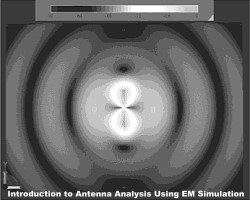Introduction to Antenna Analysis Using EM Simulation
|
|
Click here for the complete list of RF Cafe Quizzes. Note: Some material based on books have quoted passages.
Note: Sonnet Lite is a free download provided by the Sonnet company, of Syracuse, NY.
1. What was the James C. Ratio's first antenna design program? a) AntDes b) Annie c) JimAnt d) RadPat
2. Just exactly what is an antenna? a) Any metal structure b) Any non-metallic structure c) Any structure that performs the function of transmitting and receiving electromagnetic waves. d) The little feely thing on the bugs' heads
a) λ/10 from the antenna b) λ/2 from the antenna c) 1λ from the antenna d) 2λ from the antenna
4. What does a time-varying magnetic field generate? a) An electric field b) An orthogonal magnetic field c) An amplitude modulated gravity wave d) Cancellation of all fields
5. What is the impedance of a minimum-loss coaxial cable with an air dielectric? a) 25 Ω b) 50 Ω c) 75 Ω d) 100 Ω
6. How is dielectric material modeled in an EM simulator? a) Series RC b) Parallel RC c) Series RL d) Parallel RL
7. What happens to magnetic flux if current through the loop is doubled? a) It also doubles b) It increases as the square of the current c) It increases as the square root of the current d) It increases as the 4th power of the current
8. For an input power of 1 W, what is the output power of a lossless passive antenna with a specified gain of 3 dB or 6 dB? a) 1/2 W and 1 W, respectively b) 1 W for both gains c) 2 W and 4 W, respectively d) 3 W and 6 W, respectively
9. Where does a log-periodic antenna get its name? a) The shape resembles a log with straight branches b) It is the dual of the linear antenna c) From logarithmic diameter ratios of the radiating elements d) From the logarithmic spacing and length of its dipoles 10. Proper test environments are crucial to reliable EM field measurements as evidenced by what factor in Heinrich Hertz's early experiments? a) Nearby AC lighting b) Metal buttons on his jacket c) Wet wooden roof from a rain storm d) A nearby pot bellied stove
Need some help? Click here for the answers and explanations. |


 3. Where is the approximate location
of the near field / far field transition?
3. Where is the approximate location
of the near field / far field transition?